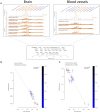Gene-mapping study of extremes of cerebral small vessel disease reveals TRIM47 as a strong candidate
- PMID: 35511193
- PMCID: PMC9255380
- DOI: 10.1093/brain/awab432
Gene-mapping study of extremes of cerebral small vessel disease reveals TRIM47 as a strong candidate
Abstract
Cerebral small vessel disease is a leading cause of stroke and a major contributor to cognitive decline and dementia, but our understanding of specific genes underlying the cause of sporadic cerebral small vessel disease is limited. We report a genome-wide association study and a whole-exome association study on a composite extreme phenotype of cerebral small vessel disease derived from its most common MRI features: white matter hyperintensities and lacunes. Seventeen population-based cohorts of older persons with MRI measurements and genome-wide genotyping (n = 41 326), whole-exome sequencing (n = 15 965), or exome chip (n = 5249) data contributed 13 776 and 7079 extreme small vessel disease samples for the genome-wide association study and whole-exome association study, respectively. The genome-wide association study identified significant association of common variants in 11 loci with extreme small vessel disease, of which the chr12q24.11 locus was not previously reported to be associated with any MRI marker of cerebral small vessel disease. The whole-exome association study identified significant associations of extreme small vessel disease with common variants in the 5' UTR region of EFEMP1 (chr2p16.1) and one probably damaging common missense variant in TRIM47 (chr17q25.1). Mendelian randomization supports the causal association of extensive small vessel disease severity with increased risk of stroke and Alzheimer's disease. Combined evidence from summary-based Mendelian randomization studies and profiling of human loss-of-function allele carriers showed an inverse relation between TRIM47 expression in the brain and blood vessels and extensive small vessel disease severity. We observed significant enrichment of Trim47 in isolated brain vessel preparations compared to total brain fraction in mice, in line with the literature showing Trim47 enrichment in brain endothelial cells at single cell level. Functional evaluation of TRIM47 by small interfering RNAs-mediated knockdown in human brain endothelial cells showed increased endothelial permeability, an important hallmark of cerebral small vessel disease pathology. Overall, our comprehensive gene-mapping study and preliminary functional evaluation suggests a putative role of TRIM47 in the pathophysiology of cerebral small vessel disease, making it an important candidate for extensive in vivo explorations and future translational work.
Keywords: GWAS; TRIM47; cerebral small vessel disease; endothelial cells; whole-exome association study.
© The Author(s) (2022). Published by Oxford University Press on behalf of the Guarantors of Brain.
Figures




References
Publication types
MeSH terms
Grants and funding
- R01 AG054076/AG/NIA NIH HHS/United States
- RF1 AG059421/AG/NIA NIH HHS/United States
- U01 AG049505/AG/NIA NIH HHS/United States
- MR/K026992/1/MRC_/Medical Research Council/United Kingdom
- R01 HL105756/HL/NHLBI NIH HHS/United States
- G0700704/MRC_/Medical Research Council/United Kingdom
- BB/F019394/1/BB_/Biotechnology and Biological Sciences Research Council/United Kingdom
- P30 AG072972/AG/NIA NIH HHS/United States
- MR/J006971/1/MRC_/Medical Research Council/United Kingdom
- R01 NS017950/NS/NINDS NIH HHS/United States
- MR/M013111/1/MRC_/Medical Research Council/United Kingdom
- G1001245/MRC_/Medical Research Council/United Kingdom
- U01 AG058589/AG/NIA NIH HHS/United States
- G0701120/MRC_/Medical Research Council/United Kingdom
- P30 AG066546/AG/NIA NIH HHS/United States
- R01 AG033193/AG/NIA NIH HHS/United States
- U01 AG052409/AG/NIA NIH HHS/United States
LinkOut - more resources
Full Text Sources
Other Literature Sources
Medical
Miscellaneous

